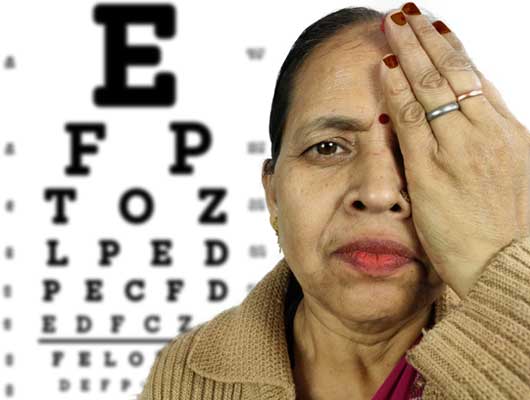
Diabetic eye disease is a group of eye problems that can affect people with diabetes. These conditions include diabetic retinopathy, diabetic macular edema, cataract, and glaucoma.
Symptoms
The best ways to manage your diabetes and keep your eyes healthy are to:
- Manage your blood glucose, blood pressure, and cholesterol
- Quit smoking
- Have a dilated eye exam once a year
Often, there are no warning signs of diabetic eye disease or vision loss when damage first develops. A full, dilated eye exam helps your doctor find and treat eye problems early—often before much vision loss can occur.
How does diabetes affect my eyes?
Most serious diabetic eye diseases begin with blood vessel problems. The four eye diseases that can threaten your sight are:
Diabetic retinopathy
The retina is the inner lining at the back of each eye. The retina senses light and turns it into signals that your brain decodes, so you can see the world around you. Damaged blood vessels can harm the retina, causing a disease called diabetic retinopathy.
In early diabetic retinopathy, blood vessels can weaken, bulge, or leak into the retina. This stage is called nonproliferative diabetic retinopathy.
If the disease gets worse, some blood vessels close off, which causes new blood vessels to grow, or proliferate, on the surface of the retina. This stage is called proliferative diabetic retinopathy. These abnormal new blood vessels can lead to serious vision problems.
Diabetic macular edema
The part of your retina that you need for reading, driving, and seeing faces is called the macula. Diabetes can lead to swelling in the macula, which is called diabetic macular edema. Over time, this disease can destroy the sharp vision in this part of the eye, leading to partial vision loss or blindness. Macular edema usually develops in people who already have other signs of diabetic retinopathy.
Glaucoma
Glaucoma is a group of eye diseases that can damage the optic nerve—the bundle of nerves that connects the eye to the brain. Diabetes doubles the chances of having glaucoma, which can lead to vision loss and blindness if not treated early.
Cataract
The lenses within our eyes are clear structures that help provide sharp vision—but they tend to become cloudy as we age. People with diabetes are more likely to develop cloudy lenses, called cataracts. People with diabetes can develop cataracts at an earlier age than people without diabetes. Researchers think that high glucose levels cause deposits to build up in the lenses of your eye
Who is more likely to develop diabetic eye disease?
- High blood glucose that is not treated
- High blood pressure that is not treated
- High blood cholesterol and smoking may also raise your risk for diabetic eye disease.
What are the symptoms of diabetic eye disease?
Often there are no early symptoms of diabetic eye disease. You may have no pain and no change in your vision as damage begins to grow inside your eyes, particularly with diabetic retinopathy.
When symptoms do occur, they may include:
- blurry or wavy vision
- frequently changing vision—sometimes from day to day
- dark areas or vision loss
- poor colour vision
- spots or dark strings (also called floaters)
- flashes of light
When should I see a doctor right away?
Visit your eye doctor right away if you notice sudden changes to your vision, including flashes of light or many more spots (floaters) than usual. You also should see a doctor right away if it looks like a curtain is pulled over your eyes. These changes in your sight can be symptoms of a detached retina, which is a medical emergency.
How do doctors diagnose eye problems from diabetes?
Having a full, dilated eye exam is the best way to check for eye problems from diabetes. Your doctor will place drops in your eyes to widen your pupils. This allows the doctor to examine a larger area at the back of each eye, using a special magnifying lens. Your vision will be blurry for a few hours after a dilated exam.
Your doctor will also
- test your vision
- measure the pressure in your eyes
Most people with diabetes should see an eye care professional once a year for a complete eye exam. The frequency of visits to your eye doctor may vary based on your type of diabetes, the time since you were first diagnosed and if you already have some type of diabetic eye disease.
How do doctors treat diabetic eye disease?
Doctors may treat advanced eye problems with medicine like anti-VEGFs, laser treatments, surgery, or a combination of these options.
